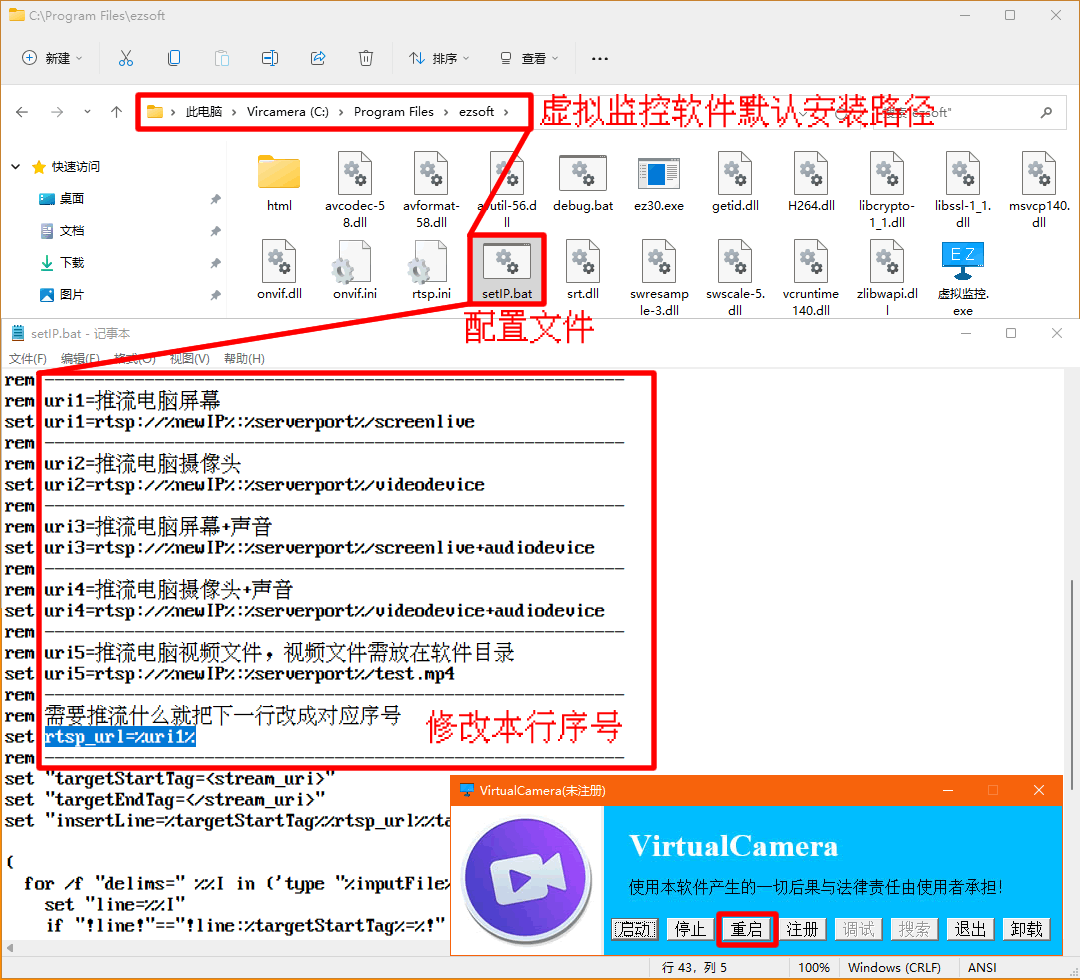play_rtsp.bat备份
echo off setlocal enabledelayedexpansion :----------------------------------------------------------- if not "%~1"=="" (set "url=%~1"&goto :play) if exist "qie.conf" (for /f "skip=1 tokens=*" %%a in (qie.conf) do (set "url=%%a"&goto :play)) set "url=http://bakevision.tpddns.cn:5555/0.m3u8" :----------------------------------------------------------- :play cd /d %~dp0 nircmd.exe setdisplay 1920 1080 32 start play_rtsp.dll -fullscreen --title=VirtualCamera --no-window-dragging !url! tasklist | find /i "osd.exe" || start C:\ezsoft\lib\osd.exe ping -n 3 127.0.0.1 >NUL taskkill /f /im "play_mp4.dll" endlocal exit
MPV播放RTSP视频流自动断网重连
mpv 是一个强大的多媒体播放器,支持多种协议和格式。当使用 mpv 播放 RTSP 流时,可能会遇到断线重连的问题。为了解决这个问题,你可以使用以下方法:
-
使用
-reconnect选项:-
mpv支持-reconnect选项,用于在播放流时自动尝试重新连接。 -
例如:
mpv -reconnect infinite rtsp://your_stream_url -
infinite表示无限次尝试重连。你也可以指定一个数字,表示尝试重连的次数。
-
-
使用
--reconnect-delay选项:-
当你使用
-reconnect选项时,你可能还想指定每次重连之间的延迟时间。 -
例如:
mpv -reconnect infinite --reconnect-delay 5 rtsp://your_stream_url - 这将在每次重连之间等待 5 秒。
-
当你使用
-
使用
--stream-reconnect选项:- 这是一个更具体的选项,用于流的重连。
-
例如:
mpv --stream-reconnect=yes rtsp://your_stream_url
-
检查其他相关的选项:
-
你还可以使用其他与网络连接和流播放相关的选项,例如
--network-timeout,以调整网络超时时间。 -
使用
mpv --help或查看官方文档来获取更多关于这些选项的信息。
-
你还可以使用其他与网络连接和流播放相关的选项,例如
-
注意:
- RTSP 流的质量和稳定性很大程度上取决于源服务器和你的网络环境。即使设置了重连,如果服务器频繁断开或网络条件很差,你也可能会遇到播放问题。
- 在某些情况下,使用 RTMP 或其他协议可能更为稳定。
希望这些建议能帮助你解决 mpv 播放 RTSP 流时的断线重连问题!
FFMPEG推流参数注释
2024-2-2 乱云飞 评论(0) 浏览(31) 标签: ffmpeg 桌面推流 捕获桌面 RTSP推流 声卡推流
![[该内容已加密,请点击标题输入密码访问]](/ez/jiami.png)
巨爆无人直播推流软件推流电脑屏幕和声卡音频配置文件
2024-1-26 乱云飞 代码 评论(0) 浏览(9) 标签: 配置文件 巨爆软件 无人直播 推流软件 推流电脑屏幕 推流音频
![[该内容已加密,请点击标题输入密码访问]](/ez/jiami.png)
buding
https://webcdn.m.qq.com/spcmgr/download/QQSoftMgrInst_patch_20220621.exe通过修改Hosts屏蔽小米红米手机各种隐私上报
2024-1-20 乱云飞 电脑 评论(0) 浏览(112)
# Block_Xiaomi_Redmi_privacy_reporting_Hosts Start 127.0.0.1 localhost ::1 localhost #屏蔽MIUI应用检测 0.0.0.0 log.avlyun.sec.intl.miui.com 0.0.0.0 update.avlyun.sec.miui.com 0.0.0.0 ixav-cse.avlyun.com 0.0.0.0 logupdate.avlyun.sec.miui.com 0.0.0.0 miui-fxcse.avlyun.com 0.0.0.0 sdkconf.avlyun.com 0.0.0.0 miav-cse.avlyun.com 0.0.0.0 api.installer.xiaomi.com 0.0.0.0 tmfsdk.m.qq.com 0.0.0.0 a0.app.xiaomi.com #屏蔽后无法矫正流量,但是也用来下载白名单 0.0.0.0 api.sec.miui.com 0.0.0.0 adv.sec.miui.com 0.0.0.0 flash.sec.miui.com #禁用后将无法云扫描病毒 127.0.0.1 etl-xlmc-ssl.sandai.net 127.0.0.1 cn.app.chat.xiaomi.net #MIUI浏览器网址拦截 127.0.0.1 browser.sentry-cdn.com 127.0.0.1 security.browser.miui.com 127.0.0.1 httpdns.browser.miui.com 127.0.0.1 activity.browser.intl.miui.com #MIUI浏览器去广告 127.0.0.1 hd.browser.miui.com 127.0.0.1 hd-preview.browser.miui.com 127.0.0.1 r.browser.miui.com 127.0.0.1 nav.browser.miui.com 127.0.0.1 reader.browser.miui.com #MIUI去广告 127.0.0.1 a.stat.xiaomi.com 127.0.0.1 abtest.mistat.xiaomi.com 127.0.0.1 ad.intl.xiaomi.com 127.0.0.1 ad.mi.com 127.0.0.1 ad.xiaomi.com 127.0.0.1 adinfo.ra1.xlmc.sec.miui.com 127.0.0.1 adv.sec.intl.miui.com 127.0.0.1 adv.sec.miui.com 127.0.0.1 api.ad.intl.xiaomi.com 127.0.0.1 api.ad.xiaomi.com 127.0.0.1 api.brs.intl.miui.com 127.0.0.1 api.collect.data.intl.miui.com 127.0.0.1 api.d.xiaomi.com 127.0.0.1 api.developer.xiaomi.com 127.0.0.1 api.e.mi.com 127.0.0.1 api.newsfeed.intl.miui.com 127.0.0.1 api.setting.intl.miui.com 127.0.0.1 api.tw06.xlmc.sec.miui.com 127.0.0.1 auth.be.sec.miui.com 127.0.0.1 authbe.sec.intl.miui.com 127.0.0.1 bss.pandora.xiaomi.com 127.0.0.1 cc.sys.intl.xiaomi.com 127.0.0.1 cc.sys.miui.com 127.0.0.1 ccc.sys.intl.xiaomi.com 127.0.0.1 ccc.sys.miui.com 127.0.0.1 cdn.ad.xiaomi.com 127.0.0.1 de-mi-nis-ner.info 127.0.0.1 de-mi-nis-ner2.info 127.0.0.1 de-ner-mi-nis4.info 127.0.0.1 de-nis-ner-mi-5.info 127.0.0.1 de.pandora.xiaomi.com 127.0.0.1 diagnosis.ad.intl.xiaomi.com 127.0.0.1 diagnosis.ad.xiaomi.com 127.0.0.1 dvb.pandora.xiaomi.com 127.0.0.1 e.ad.xiaomi.com 127.0.0.1 etl.xlmc.sec.miui.com 127.0.0.1 tracking.miui.com 127.0.0.1 fcanr.tracking.miui.com 127.0.0.1 find.my-xiaomi.live 127.0.0.1 gallery.pandora.xiaomi.com 127.0.0.1 geofence.sys.miui.com 127.0.0.1 globalapi.ad.xiaomi.com 127.0.0.1 go.mi.edu 127.0.0.1 hysdkservice.g.mi.com 127.0.0.1 inpost-polska-mi.order6457.me 127.0.0.1 jellyfish.pandora.xiaomi.com 127.0.0.1 lite.a.market.xiaomi.com 127.0.0.1 log.ad.xiaomi.com 127.0.0.1 m.track.ad.xiaomi.com 127.0.0.1 mazu.sec.miui.com 127.0.0.1 metok.sys.miui.com 127.0.0.1 mgvrst.mi-shop.com 127.0.0.1 mi-de-ner-nis3.info 127.0.0.1 mi-manga-hentai.blogspot.com 127.0.0.1 mi-mercadito.mx 127.0.0.1 mi-olx.pl 127.0.0.1 mi-trophy.co.uk 127.0.0.1 mi-xioami.com 127.0.0.1 mi.5.p2l.info 127.0.0.1 mi.adinterax.com 127.0.0.1 mi.atm.youku.com 127.0.0.1 mi.btmods.net 127.0.0.1 mi.eulerian.net 127.0.0.1 mi.gdt.qq.com 127.0.0.1 mi.miliboo.be 127.0.0.1 mi.miliboo.ch 127.0.0.1 mi.miliboo.co.uk 127.0.0.1 mi.miliboo.com 127.0.0.1 mi.miliboo.de 127.0.0.1 mi.miliboo.es 127.0.0.1 mi.miliboo.it 127.0.0.1 mi.miliboo.lu 127.0.0.1 mi.speee.jp 127.0.0.1 mi.tvzhe.com 127.0.0.1 misc.pandora.xiaomi.com 127.0.0.1 mishop.pandora.xiaomi.com. 127.0.0.1 miui.hftaili.com 127.0.0.1 mivideo.g.mi.com 127.0.0.1 mp.huangye.miui.com 127.0.0.1 ner-de-mi-nis-6.info 127.0.0.1 o2o.api.xiaomi.com 127.0.0.1 olx-mi.pl 127.0.0.1 preview-api.installer.xiaomi.com 127.0.0.1 resolver.gslb.mi-idc.com 127.0.0.1 sa.api.intl.miui.com 127.0.0.1 sgp.o2o.api.xiaomi.com 127.0.0.1 shenghuo.xiaomi.com 127.0.0.1 site.e.mi.com 127.0.0.1 ssp.xiaomi.com 127.0.0.1 staging.sdkconfig.ad.xiaomi.srv 127.0.0.1 sdkconfig.ad.xiaomi.com 127.0.0.1 starfish.pandora.xiaomi.com 127.0.0.1 stat.pandora.xiaomi.com 127.0.0.1 stat.xiaomi.com 127.0.0.1 storeconfig.mistat.intl.xiaomi.com 127.0.0.1 t.track.ad.xiaomi.com 127.0.0.1 t1.a.market.xiaomi.com 127.0.0.1 t2.a.market.xiaomi.com 127.0.0.1 t3.a.market.xiaomi.com 127.0.0.1 t4.a.market.xiaomi.com 127.0.0.1 t5.a.market.xiaomi.com 127.0.0.1 t6.a.market.xiaomi.com 127.0.0.1 test.ad.xiaomi.com 127.0.0.1 test.e.ad.xiaomi.com 127.0.0.1 test.zeus.ad.xiaomi.com 127.0.0.1 tr.news.mi-oferta.es 127.0.0.1 track.ad.xiaomi.com 127.0.0.1 upgrade.mishop.pandora.xiaomi.com 127.0.0.1 url8807.global.passport.xiaomi.com 127.0.0.1 video.market.xiaomi.com 127.0.0.1 www.find.my-xiaomi.live 127.0.0.1 www.inpost-polska-mi.order6457.me 127.0.0.1 www.mi-manga-hentai.blogspot.com 127.0.0.1 www.mi-olx.pl 127.0.0.1 www.olx-mi.pl 127.0.0.1 xiaomi-dtv.m.cn.miaozhen.com 127.0.0.1 xiaomi-mipdx.cn.miaozhen.com 127.0.0.1 xiaomi.m.cn.miaozhen.com 127.0.0.1 xlmc.sec.miui.com 127.0.0.1 zeus.ad.intl.xiaomi.com 127.0.0.1 zeus.ad.xiaomi.com # Update url: https://raw.gitmirror.com/743859910/Block_Xiaomi_Redmi_privacy_reporting_Hosts/master/Block_Xiaomi_Redmi_privacy_reporting_Hosts.txt # Star me: https://github.com/743859910/Block_Xiaomi_Redmi_privacy_reporting_Hosts # Block_Xiaomi_Redmi_privacy_reporting_Hosts End
修改配置

VB6.0读取配置文件
Private Sub Command1_Click()
Dim fileContent As String
' 调用函数并获取文件内容
fileContent = ReadLine("1.conf", 5)
' 显示指定行数的内容
If fileContent <> "" Then
Label1.Caption = fileContent
MsgBox fileContent
Else
MsgBox "文件内容不足指定行数"
End If
End Sub
Private Function ReadLine(filePath As String, lineNumber As Integer) As String
Dim fileContent As String
' 打开文件并读取指定行数的内容
With CreateObject("Scripting.FileSystemObject").OpenTextFile(filePath)
For i = 1 To lineNumber
fileContent = .ReadLine
Next i
.Close
End With
' 返回指定行数的内容
ReadLine = fileContent
End Function
最新版本虚拟监控软件下载链接20240116
https://pan.baidu.com/s/1I7ClvsmHMBJ-OURDvxONPw?pwd=v5dqhttp://v.bakevision.cn/down/onvif_20240116.exe
https://www.123pan.com/s/PCf7Vv-BgRJv.html
http://1.80c.cc:5000/sharing/WrBdIjLJs
https://share.weiyun.com/QgRW8XhG
https://lanzoui.com/iFCp71l6ntxe
http://1.80c.cc:5100/
批处理读取配置文件
@echo offsetlocal enabledelayedexpansion
set "file=1.txt"
set "lineCount=0"
for /f "tokens=*" %%a in (%file%) do (
set /a lineCount+=1
if !lineCount!==1 set "param1=%%a"
if !lineCount!==2 set "param2=%%a"
if !lineCount!==3 set "param3=%%a"
)
echo Parameter 1: %param1%
echo Parameter 2: %param2%
echo Parameter 3: %param3%
cmd/k
===========================================
@echo off
::------------------------------------------
setlocal enabledelayedexpansion
set "line=0"
for /f "tokens=*" %%a in (1.txt) do (
set /a "line+=1"
if !line!==1 set "url=%%a"
)
::------------------------------------------
echo %url%
cmd/k
===========================================
@echo off
set /p url=<1.txt
for /f "skip=2 delims=" %%a in (1.txt) do set url=%%a&goto next
:next
echo %url%
cmd/k

